Originally printed in the March 2018 issue of Produce Business.
 With more and more Americans focused on health and wellness, foodservice leaders and chefs are trying to meet the demands of their customers with a greater variety of healthful options. The National Restaurant Association’s 2017 State of the Industry report revealed that 70 percent of adults say the availability of healthy menu options would make them choose one restaurant over another.
With more and more Americans focused on health and wellness, foodservice leaders and chefs are trying to meet the demands of their customers with a greater variety of healthful options. The National Restaurant Association’s 2017 State of the Industry report revealed that 70 percent of adults say the availability of healthy menu options would make them choose one restaurant over another.
Restaurant industry leaders know they need to develop more healthful options to remain competitive and relevant to today’s diner, but there is confusion about how to define this new style of menu development. Specifically, terms such as “plant-based” and “plant-forward” are causing confusion among culinary and foodservice professionals.
For many years, nutrition professionals have promoted plant-based diets, the most popular being the traditional Mediterranean diet, where fruits, vegetables and legumes are consumed in greater amounts compared to the standard American diet. Likewise, the USDA MyPlate icon depicts a plant-based dietary pattern where approximately three-fourths of a plate or meal is comprised of plant-based ingredients and the rest from animal sources.
Recently, the term “plant-based” has become more strongly associated with vegan diets. The Humane Society of the United States is now offering plant-based culinary training for major contract foodservice companies to teach culinary professionals how to make delicious, vegan food.
Restaurant industry leaders know they need to develop more healthful options to remain competitive and relevant to today’s diner.
In a recent survey of U.S. foodservice operators conducted by Datassential in late 2017, less than 40 percent were familiar with the term “plant-based” and less than 10 percent were familiar with the term “plant-forward.” When asked to choose a definition for these terms, the majority agreed plant-based means, “a menu item that contains no animal products or byproducts, instead is solely plant-based, i.e., vegan” and that plant-forward means, “menu items that focus on plant-based ingredients but not necessarily exclude meats.”
The Culinary Institute of America has been working for many years to help the volume foodservice industry develop a greater variety of more healthful menu options. It recently released guidance on plant-forward menus developed to help industry leaders communicate with customers, vendors, suppliers and the media about the distinctions among different menu strategies that highlight fruits, vegetables and other plant-based ingredients.
The Culinary Institute of America is defining plant-based this way: “used to refer to ingredients and foods themselves, i.e., fruits and vegetables (produce); whole grains; beans, other legumes (pulses) and soy foods; nuts and seeds; plant oils; and herbs and spices. Different from “plant-forward,” which refers to the style of cooking and eating that emphasizes and celebrates these foods but is not limited to them.”
The Culinary Institute of America defines plant-forward as: “a style of cooking and eating that emphasizes and celebrates, but is not limited to, plant-based foods — including fruits and vegetables (produce); whole grains; beans, other legumes (pulses) and soy foods; nuts and seeds; plant oils; and herbs and spices — and that reflects evidence-based principles of health and sustainability.”
Which ingredients are winning in this menu innovation competition? Datassential research shows operators report using more whole grains, fruits and vegetables compared to a year ago. Operators reported double digit net growth increases in the use of these ingredients. What’s being replaced? Red meat.
If you’re selling produce today, keep this in mind. Whether a chef is developing new plant-based, plant-forward or plant-centric menu items, he or she is thinking about fruits and vegetables.
Amy Myrdal Miller, MS, RDN, FAND is a farmer’s daughter from North Dakota, award-winning dietitian, culinary nutrition expert, and founder and president of Farmer’s Daughter Consulting, Inc. She is the director of The Culinary Institute of America Healthy Menus R&D Collaborative and a consultant for the Produce for Better Health Foundation. You can learn more about her business at www.farmersdaughterconsulting.com, and you can follow her insights on food and flavor on Twitter @FarmFlavorFun




